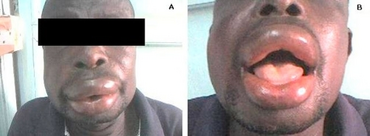Drug-induced angioedema
| Drug-induced angioedema | |
|---|---|
| Other names: Acquired angioedema | |
 | |
| ACE-I induced angioedema | |
| Specialty | Dermatology |
Drug-induced angioedema is a known complication of the use of angiotensin-converting enzyme (ACE) inhibitors, angiotensin II antagonists (ARBs), and Angiotensin-Neprilysin Inhibitor LCZ969.[1]: 120 The angioedema appears to be dose dependent as it may resolve with decreased dose.[1]: 120
Signs and symptoms
Angioedema presents itself as an abrupt onset of non-pitting, non-itchy swelling that involves the mucosal layers. Some common locations of angioedema are the face, particularly the lips and around the eyes, hands and feet, and genitalia.[2] A rare, yet serious complication is one inside the abdomen, the symptom usually being severe stomach upset, which is much less obvious than the other locations.[3]
Risk factor
Some common ACE Inhibitors are:
- Benazepril (Lotensin)
- Captopril (Capoten)
- Enalapril (Vasotec)
- Lisinopril (Prinivil, Zestril)
- Ramipril (Altace)
Some common ARBs are:
- Candesartan (Atacand)
- Losartan (Cozaar)
- Olmesartan (Benicar)
- Valsartan (Diovan)
Diagnosis
The diagnosis of drug-induced angioedema is done via, but not limited to:[4]
- Analysis of complement factors
- Tryptase levels
- Specific allergy test
Management
The treatment for this induced condition may include emergency medication as well as epinephrine.[4]
Incidence
The chance of drug-induced angioedema is extremely uncommon, however, as studies show incidence of less than 1%.[5] The reason this adverse effect may occur is due to the build-up of bradykinin, a vasodilator. This causes blood vessels to dilate and allow for fluid buildup in the mucosal surfaces.
See also
References
- ↑ 1.0 1.1 James, William; Berger, Timothy; Elston, Dirk (2005). Andrews' Diseases of the Skin: Clinical Dermatology. (10th ed.). Saunders. ISBN 0-7216-2921-0.
- ↑ Winters, Michael. “Clinical Practice Guideline: Initial Evaluation and Management of Patients Presenting
- ↑ J Community Hosp Intern Med Perspect. 2014; 4(4): 10.3402/jchimp.v4.25260
- ↑ 4.0 4.1 Lerch, Marianne (2012). "Drug-induced angioedema". Chemical Immunology and Allergy. 97: 98–105. doi:10.1159/000335621. ISSN 1662-2898. Archived from the original on 15 April 2022. Retrieved 14 April 2022.
- ↑ Banerji, Aleena. “Multicenter study of patients with angiotensin-converting enzyme inhibitor-induced angioedema who present to the emergency department.” Annals of Allergy, Asthma & Immunology (2008); 100: 327-332. Web. 2 Nov 2014
2. Angiotensin-Neprilysin Inhibition versus Enalapril in Heart Failure (PARADIGM-HF Investigators); NEJM.org, September 11, 2014; Vol.371, No.11.
External links
| Classification | |
|---|---|
| External resources |